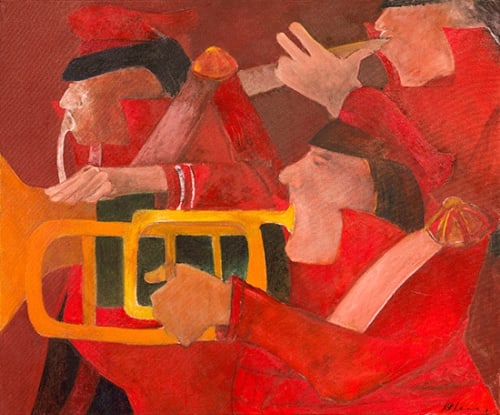Krishen Khanna is perhaps one of the most versatile modernist of our times, whose life and art has borne witness to some of the most turbulent times of India’s political history. Khanna grew up in pre-partition Lahore, before moving to England, to study at the Imperial Service College on a scholarship. These early years of life with family and friends was the subject of some of his earliest works, where he reconstructed this “small, composite world, in which religious difference and the slowly gathering tide of nationalism were only a distant rumble.” His preoccupation with everyday life that is seen in these early years will stay with him through his life. Soon his family moved due to the Partition and Khanna’s job brought them to Bombay which marked a important phase in his artistic career as it was here that he became a part of the Progressive Artist Group (PAG) with whom he would hold his first exhibition in 1949. Unlike his peers Khanna’s engagement with abstraction wasn’t simple; for him the figurative always lived alongside his experiments with abstraction. Khanna’s arguments were always for universalism of image, and affinity with Indian aesthetics and humanist values.
His bank job then took him to Madras, and it was here in 1955 that Khanna had his first solo show at the USIS. His years here saw him engaged with the human subject, those of labourers and women engaged in mundane tasks. Here his passion for music was nurtured further and his series on musicians from this period saw him convert the rhythmic sound in time into movements of brush on canvas. His preoccupation from this period, with the formal elements of colour and line, will become a part of his oeuvre occurring later in his works on bandwallas with greater passion. Soon he moved to Delhi and gave up is job to concentrate on art full time, and in 1962 was awarded the Rockefeller Fellowship and was Artist-in-Residence at the American University in Washington in the years 1963-64. Since then he has exhibited widely in India and abroad. Apart from several one man shows he has participated in group shows like the Tokyo Biennale 1957 and 1961, the Sao Paulo Biennale 1960, the Venice Biennale 1962, the Festival of India in the then USSR and Japanin 1987 and 1988. He was awarded the Padmashree in 1996.
Krishen Khanna’s works range from carefully constructed compositions to gestural, spontaneous works. His deployment of colour and strokes to evoke the human situation is unmatched. Works like his Nocturne series capture the heaviness of a worker’s tired body resting at the end of the day as faithfully as his Bandwallas series captures the exuberant energy of the band of musicians. In his many monochromatic works one sees the energy in the frenzy of lines and tension in the tight compositions, with the overall picture pulsating with the interplay of formal elements. Through a lack of physical detail; Khanna’s paintings aspire towards a quality of timelessness and universality. As an artist he defies categorisation as he simultaneously occupies multiple roles – as a narrator, as a formalist, a genre painter. He has worked on themes ranging from everyday domestic scenes to moments of historical importance, from scenes from myths and poetry to quite portraits of people from his life. He has continually worked with the contrasts between the mundane and the sublime, the ordinary and the epic dimension. Constantly oscillating between the banal and the spectacular, for Khanna’s the personal is the political and political personal.
